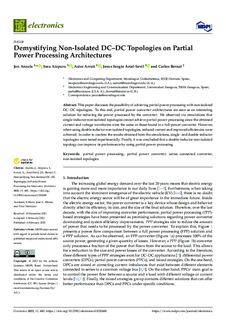
Izenburua
Demystifying Non-Isolated DC–DC Topologies on Partial Power Processing ArchitecturesBeste instituzio
Universidad de ZaragozaBertsioa
Bertsio argitaratua
Eskubideak
© 202s by the authors. Licensee MDPISarbidea
Sarbide irekiaArgitaratzailearen bertsioa
https://doi.org/10.3390/electronics11030480Non argitaratua
Electronics .Vol. 11. N. 3. N. artículo 480, 2022Argitaratzailea
MDPIGako-hitzak
Partial Power ProcessingPartial Power Converters
Series Connected Converters
non-isolated topologies
Laburpena
This paper discusses the possibility of achieving partial power processing with non-isolated DC–DC topologies. To this end, partial power converter architectures are seen as an interesting solution fo ... [+]
This paper discusses the possibility of achieving partial power processing with non-isolated DC–DC topologies. To this end, partial power converter architectures are seen as an interesting solution for reducing the power processed by the converter. We observed via simulations that single-inductor non-isolated topologies cannot achieve partial power processing since the obtained current and voltage waveforms were the same as those found in a full-power converter. However, when using double inductor non-isolated topologies, reduced current and improved efficiencies were achieved. In order to confirm the results obtained from the simulations, single- and double-inductor topologies were tested experimentally. Finally, it was concluded that a double-inductor non-isolated topology can improve its performance by using partial power processing. [-]
Bildumak
Item honek honako baimen-fitxategi hauek dauzka asoziatuta:






















